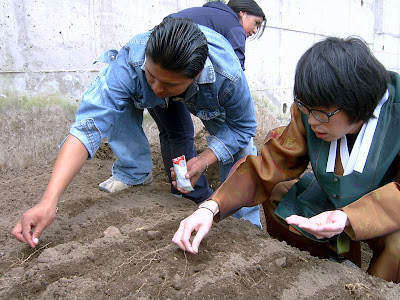 | |
〈Afiche del Seminario
Nacional sobre Metodologías para la Enseñanza Creativa, dirigido por la Empresa
“Paul&Mark” invitada por el Ministerio de Educación de Ecuador y KOICA〉
|
Por lo tanto, más del 85% de los profesores del sistema de Educación Intercultural Bilingüe no han tenido una capacitación profesional activa. Siendo una ardua tarea el alcanzar la excelencia en la calidad de la educación.
Por ello, se coordinó una capacitación profesional para brindar ciertas herramientas que son necesarias para mejorar la calidad del sistema de Educación Intercultural Bilingüe.
Así, en el invierno de 2011, en Quito, desde el 10 al 14 de septiembre, se dictó el seminario de capacitación para los maestros de los CECIBs (Centros Educativos Comunitarios Interculturales Bilingües) de Quito, funcionarios de la DINEIB (Dirección Nacional de Educación Intercultural Bilingüe) y las DIPEIBs (Direcciones Provinciales de Educación Intercultural Bilingüe).
La empresa “Paul&Mark” que es una de mejores empresas en el campo de consultoría de la educación en Corea, quiso transmitir su conocimiento para los actores de la educación indígena del Ecuador. Por ello, este seminario pudo realizarse gracias a la colaboración de la empresa “Paul&Mark” quienes lo hicieron en calidad de ayuda social sin recibir ningún valor a cambio.
Los contenidos del seminario fueron:
Taller 1: (10~11 de septiembre) – Enseñanza Acelerada para los profesores del sistema de Educación Intercultural Bilingüe. (Total 80 participantes)
Taller 2: (12 de septiembre) – Creatividad para las autoridades y los funcionarios del Ministerio de Educación y Organizaciones Gubernamentales del Ecuador. (Total 200 participantes)
Taller 3: (13 de septiembre) – Comunicación para los funcionarios de la DINIEB y los aliados del proyecto “Escuelas de las Montañas” (Total 30 participantes)
Taller 4: (14 de septiembre) – Plan de Vida para los miembros del Barrio Santa María en donde está el CECIB “Juan Carlos Peralta”. (Total 30 participantes)
Taller 5: (15 de septiembre) – Enseñanza Acelerada para los funcionarios del DIPEIB-NAPO y los profesores. (Total 30 participantes)
 |
<Los profesores
del Sistema de Educación Intercultural Bilingüe disfrutando en el seminario>
|
 |
<Una foto
conmemorativa después del seminario, “¡Que bestia!”>
|
En el segundo y tercer taller, se realizó la capacitación con respecto a “La Creatividad y Comunicación”, asistiendo a este curso los funcionarios de las organizaciones que están cooperando en el proyecto “Escuelas de las Montañas” como: MSP, MIES, SECAP y Embajada de EE.UU, etc.
El cuarto taller fue muy especial para todos, pues se realizó la capacitación sobre “El Plan de Vida”, lo que representó un mensaje de esperanza para los miembros del barrio con quienes se ha trabajado por más de un año y medio en el proyecto “Escuelas de las Montañas”. Se pudo ver la felicidad y el deseo de seguir adelante luchando por sus sueños, eso es lo que inspiró Paul&Mark a todos quienes asistimos en el evento.
Ante todo, les agradecemos mucho desde nuestro corazón a las personas maravillosas de “Paul&Mark” quienes vinieron a Ecuador desde Corea, del lado opuesto del globo para compartir su conocimiento y corazón con muchas personas del Ecuador, Paul Choi, Su esposa, ShinYoung Park, PyeongAhn Kang, JiMyeong Yi y MinKyu Lee, voluntario de KOICA que tradujo todo el evento, poniendo su mejor esfuerzo y concentración durante el desarrollo del seminario.
| Otros artículos del proyecto |
|---|
※ Quieres poner comentarios en este articulo?














